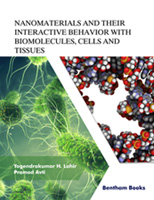Nanoscience is a multidisciplinary area of science which enables researchers to create tools that help in understanding the mechanisms related to the interactions between nanomaterials and biomolecules (nanotechnology). Nanomaterials represent nanotechnology products. These products have an enormous impact on technical industries and the quality of human life. Nanomaterials directly or indirectly have to interact with biosystems. It is, therefore, essential to understand the beneficial and harmful interactions of nanomaterials with and within a biosystem, especially with reference to humans.
Nanomaterials and Their Interactive Behavior with Biomolecules, Cells and Tissues provides primary and advanced information concerning the interactions between nanomaterials and the components of a typical biosystem to readers. Chapters in the book cover, in a topic-based approach, the many facets of nanomolecular interactions with biological molecules and systems that influence their behavior, bioavailability and biocompatibility (including nucleic acids, cell membranes, tissues, enzymes and antibodies). A note on the applications of nanomaterials is also presented in the conclusion of the book to illustrate the usefulness of this class of materials.
The book is written in a manner that makes it easy to understand mathematical concepts related to nanomolecular interactions. Readers will be able to relate concepts from chemistry, physics and biology in a fluid manner with existing technologies and applications.
The contents of the book will benefit students, researchers, and technicians involved in the fields of biological sciences, such as cell biology, medicine, molecular biology, food technology, cosmetology, pharmacology, biotechnology, and environmental sciences. The book also provides information for the material science personnel, enabling them to understand the basics of target-oriented nanomaterials design for specific objectives.
About the Authors:
Dr. Y.K. Lahir received his Ph.D. and DHE diploma from the University of Bombay, India. He is currently a part of the visiting faculty of the Department of Biophysics of the University of Mumbai, India. He is a life member of The Indian Biophysics Society, and Society for Radiation Research, and Environmental Mutagenic Society of India. He has authored three books on toxicology and 55 research papers, with some review articles and book chapters. His research fields include toxicological studies, nanotoxicological studies, interactions with erythrocytes, and chromosomal fluctuations, among others.
Dr. Pramod Avti previously served as a research associate and a postdoctoral fellow at the Department of Electrical Engineering and Biomedical Engineering of Ecole Polytechnique, Montreal, Canada. He has published more than 50 research articles, reviews, and book chapters, and is a member of the National Academy of Medical Sciences. His research interests include nanomaterials, bionanomaterials, biomedical optics, biomedical engineering, and regenerative medicine.
Keywords: Nanoscience, nanotechnology, nanomolecular interactions, bioavailability, biocompatibility, biomolecules, biotechnology
For further information, please visit: https://bit.ly/3h8tlEI

